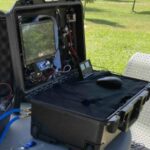
Charcoal rot, caused by the notorious soilborne fungus Macrophomina phaseolina (Mp), has long stood as a formidable adversary to global soybean production. Known for its insidious nature, this pathogen thrives under hot and dry environmental conditions, silently compromising plant health even before visible symptoms manifest. Now, pioneering research has leveraged cutting-edge geostatistical modeling to generate high-resolution risk maps, empowering growers with unprecedented foresight into disease prevalence grounded directly in subsoil characteristics.
The breakthrough study, recently published in the esteemed journal Phytopathology, was spearheaded by Horacio Lopez-Nicora, Assistant Professor at The Ohio State University specializing in Soybean Pathology and Nematology, alongside postdoctoral researcher Sandip Mondal. The research team undertook an extensive sampling effort, collecting soil specimens from 297 distinct soybean fields spanning seven departments throughout Paraguay—a critical hub for South American soybean cultivation. This expansive dataset underpinned their analysis, revealing a striking geographic pattern: Macrophomina phaseolina exhibits significantly elevated colony-forming unit (CFU) abundance in the country’s southeastern sector, correlating strongly with regions characterized by acidic soils and elevated clay content.
Central to the study’s success was the deployment of advanced geostatistical techniques, including both ordinary kriging and co-kriging interpolation methods, allowing researchers to spatially predict Mp abundance with high precision. By integrating key soil physicochemical parameters—soil pH, clay fraction, and cation exchange capacity—into their predictive models, the team derived intricate maps delineating areas at varying degrees of infection risk. Importantly, these soil attributes emerged as robust predictors of Mp proliferation; notably, lower soil pH values were inversely linked with fungal population density, emphasizing the critical role of edaphic factors in disease ecology.
Beyond mere prevalence, the spatial distribution of Macrophomina phaseolina was elucidated through the application of spatial regression analyses complemented by Moran’s I statistic, a measurement of spatial autocorrelation. These analyses confirmed that Mp presence is not randomly dispersed but rather forms distinct clusters or hotspots, governed by underlying soil conditions. This clustering phenomenon highlights how traditional scouting, which often relies on symptomatic observation, may miss early or subclinical fungal presence, underscoring the value of proactive risk assessment through soil-based surveillance.
According to Sandip Mondal, this spatial heterogeneity reflects the pathogen’s dependency on precise microenvironmental niches within the soil. The pathogen does not behave uniformly across fields but ‘pops up’ selectively where conducive conditions align—a phenomenon now resolvable thanks to their geostatistical toolkit. This insight bears profound implications for precision agriculture, offering a pathway to target disease management interventions specifically to high-risk zones without expending resources unnecessarily across entire fields.
Harnessing this data-driven approach permits growers to tailor management techniques more strategically—altering planting dates to avoid peak pathogen activity, employing crop rotations that disrupt the Mp life cycle, and applying soil amendments judiciously to modify unfavorable soil chemistry. Such targeted approaches not only enhance disease control efficacy but also contribute to sustainable farming by minimizing environmental impacts and reducing input costs. Importantly, the mapping tools deliver actionable intelligence well before disease symptoms threaten yields, facilitating early intervention.
Co-author Emile Gluck-Thaler, Assistant Professor at the University of Wisconsin-Madison, emphasizes that the broader implications extend beyond individual farm management. The integration of soil data with pathogen forecasting offers policymakers scalable frameworks to reinforce national and regional crop protection strategies. By embedding such predictive models into agricultural extension and biosecurity programs, countries vulnerable to climate variability and emergent pathogens may bolster food security effectively, particularly as weather extremes exacerbate disease pressures.
The research team’s international collaboration—featuring partners from the University of Wisconsin–Madison, Universidad Nacional de Asunción, and Universidad Católica in Paraguay—exemplifies the power of uniting cross-continental expertise to address pressing agricultural challenges. Their work sets a new standard in how soil science and spatial analytics converge to revolutionize disease management, transforming it from reactive symptom-based approaches to proactive, data-centric paradigms.
Crucially, the study’s methodological rigor and comprehensive sampling underpin its scientific robustness. The dual use of ordinary kriging and co-kriging offered comparative insight into interpolation efficacy, with co-kriging incorporating secondary variables such as soil texture improving predictive accuracy. These geostatistical techniques offer a template adaptable to other pathosystems, paving the way for wider application in forecasting soilborne diseases that have thus far remained elusive due to their cryptic soil phase.
As global climates trend toward increasing aridity and temperature fluctuations, the threat posed by Macrophomina phaseolina is projected to intensify, making early-warning systems indispensable. The integration of statistically validated risk maps into agronomic planning enables stakeholders to anticipate outbreaks, allocate resources efficiently, and ultimately safeguard crop productivity against this stealthy but devastating pathogen. The study heralds a future in which spatial data science and plant pathology coalesce, fostering resilient agricultural ecosystems capable of withstanding emerging biotic stresses.
Horacio Lopez-Nicora succinctly captured the study’s transformative potential, stating, “This isn’t just about soybeans or one disease—it’s a demonstration of how spatial data and soil science can transform farming into a more predictive, efficient, and sustainable system.” Their findings signal a paradigm shift, wherein the subterranean world beneath our crops is no longer a black box but an open book guiding next-generation disease management.
For detailed insights into the modeling approach and spatial analyses underpinning these findings, readers can consult the full text titled “Geostatistical Modeling Improves Prediction of Macrophomina phaseolina Abundance and Distribution in Soybean Fields,” published in Phytopathology.
Subject of Research:
Prediction and spatial distribution of Macrophomina phaseolina abundance in soybean fields using geostatistical modeling.
Article Title:
Geostatistical Modeling Improves Prediction of Macrophomina phaseolina Abundance and Distribution in Soybean Fields
News Publication Date:
21-Mar-2025
Web References:
https://apsjournals.apsnet.org/journal/phyto
https://doi.org/10.1094/PHYTO-04-24-0139-R
Image Credits:
Credit: Horacio D. Lopez-Nicora, © 2025 The American Phytopathological Society
Keywords:
Soybeans, Fungal infections, Plant diseases, Risk factors, Mycology, Soil fungi, Statistical analysis, Plant pathogens, Crop science, Crop production
Tags: advanced interpolation techniques in agriculturecharcoal rot detection in soybeanearly warning systems for crop diseasesenhancing soybean yield through disease predictiongeostatistical modeling in agriculturehigh-resolution agricultural risk mapsimpact of acidic soils on soybean healthMacrophomina phaseolina risk mappingParaguay soybean production challengessoilborne pathogens in soybean cultivationsoybean disease management strategiesspatial analysis of soybean pathogens


